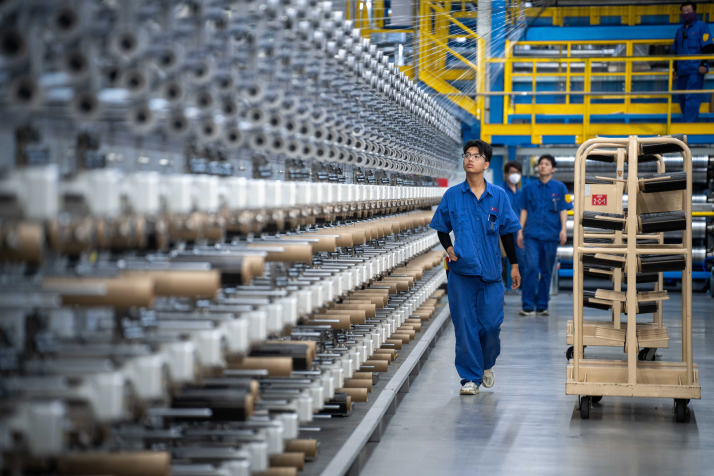| China |
| Jilin's bold reinvention: old lands, new tech and far-reaching trade | |
|
|
 Workers monitor operations on an automated production line at a carbon fiber workshop of Jilin Chemical Fiber Group in Jilin City, Jilin Province, on July 16 (XINHUA)
Poised on the edge of Northeast Asia, where China meets the Korean Peninsula and Russia's Far East, Jilin Province emerges as a mosaic—its identity woven from rugged borderlands, industrial legacy and 21st-century ambition. Once an industrial powerhouse fueling China's planned economy (1949-78). Today, Jilin gracefully balances heritage and innovation, boldly reshaping its identity through innovative reforms, hi-tech industries and flourishing trade networks. At 43 degrees north latitude, sunlight bathes Jilin's land in a golden glow, symbolizing renewal and prosperity beyond its geographical advantage. Here, fertile black soil nurtures lush rice paddies that have blossomed into active tourist destinations, echoing with laughter and cultural exchange. Nearby, towering carbon fiber factories stretch their hi-tech filaments into the sturdy "backbones" that empower renewable wind energy. At bustling land and border ports like Changchun and Hunchun, cranes and containers tirelessly bridge oceans and continents, connecting inland China to the global tapestry. Agriculture, industry and trade, these powerful strokes paint a portrait of a province reinventing itself, charting a path from its industrial legacy toward a future brimming with promise and innovation. Rural renaissance Jilin's innovative combination of modern agriculture and cultural tourism exemplifies its commitment to sustainable development, with Guangdong Village in Yanbian Korean Autonomous Prefecture a prime example. Strategically located in the world's "golden rice belt," the village leverages its ecological advantages to cultivate renowned organic rice brands like Maxida, which means "delicious" in Korean. Over the past decade, the village has successfully transformed itself into a national benchmark for rural revitalization, establishing an extensive agricultural value chain that includes cultivation, processing and targeted online marketing. China's rural revitalization, a strategy introduced at the 19th Communist Party of China (CPC) National Congress in 2017, promotes the economic prosperity and overall development of rural areas. It builds on the success of the nationwide poverty alleviation campaign that had eradicated absolute poverty as of late 2020. With agricultural cooperatives and family-owned farms, Guangdong has boosted local economic conditions through innovations like contract-based sales. Jin Jun, a 43-year-old village resident, highlighted Guangdong's rice industry success, particularly in international markets like Japan. After studying in Japan, Jin returned to his hometown in 2009, inspired by the country's sophisticated rice branding. "As our rice quality matches Japan's, there must be a huge market," Jin told Chinese reporters during a group interview on July 18. The village's organic rice sales have greatly increased, selling over 1,200 tons in 2024 alone, marking a nearly seven-fold increase compared to a decade ago. Recently, the village received an order for 300 tons, solidifying its international presence. The rice industry's growth benefits over 400 local households, including 69-year-old Zhou Meihao, who contracts 3.9 hectares of rice fields that earn him an annual net income exceeding 40,000 yuan ($5,600). Moreover, integrating agricultural and tourism projects, the village features attractions like mini-trains, crab-fishing parks and even a new scenic cable car gliding just above the rice paddies. It also has interactive rice museums and authentic ethnic Korean homestays, drawing nearly 400,000 visitors annually.  A livestream host promotes locally grown rice in Dongala Village in Hunchun, Jilin, on May 6. The city is situated in the borderlands of China, the Democratic People's Republic of Korea and Russia (XINHUA)
These offerings not only generate substantial tourism revenue but also enhance cultural interaction through events showcasing traditional performances, immersive farming experiences and local cuisine. "Visitors to Guangdong can experience traditional Korean ethnic cuisine, stay in our distinctive Korean-style homestays and engage deeply with local folk culture," said Zhang Huiling, Deputy General Manager of Guangdong Korean Ethnic Folk Tourism Co., a village-owned enterprise. Guangdong represents the transformative power of blending modern agriculture with cultural heritage, improving local quality of life. It stands as a model for Jilin's multifaceted approach to rural revitalization, illustrating a replicable approach for sustainable and culturally enriched rural development. Stronger than steel One key example central to Jilin's industrial revival is the Jilin Chemical Fiber Group (JLFiber), a vital driver of economic innovation—both regionally and nationally. Established in 1959, the company has adeptly navigated the transition from traditional rayon production to pioneering carbon fiber technology. Underpinning this evolution is a steadfast commitment to innovation, sustainability and market adaptability. Carbon fiber is just one 10th the thickness of a hair, but can be seven to nine times stronger than steel. Inside JLFiber's exhibition hall, Deputy General Manager Sun Xiaojun proudly showcased the "black gold" to reporters on July 16, stressing its remarkable strength. "A bundle of 50,000 carbon fibers can pull a bull!" Sun explained, referring to carbon fiber bundles containing tens of thousands of individual filaments. This lightweight yet extremely durable material is transforming numerous sectors. On display inside the hall were products ranging from outdoor gear like skis, tennis rackets, fishing rods and bicycles to industrial applications such as wind turbine blades, drone propellers and car parts. Producing carbon fiber involves a precise and complex process. Inside the carbonization workshop, bundles of white precursor fiber undergo oxidation, carbonization and drying, transforming into glossy black filaments through automated production lines stretching over 400 meters. The company now holds globally leading patents and production lines for precursor and carbon fiber manufacturing. The company's groundbreaking progress in carbon fiber has reshaped industries including wind energy, automotive manufacturing and aerospace, reducing domestic companies' reliance on imported high-performance materials. Deputy Secretary of the CPC JLFiber Committee Wang Hong reflected on the company's transformation from relying on foreign imports to pioneering domestic innovation. In 2006, JLFiber established a dedicated carbon fiber research and development team, initially funding its efforts through profits from traditional chemical fiber products. After years of persistent efforts, the team achieved large-scale production of precursor fibers by 2012. In the first half of 2025, JLFiber's carbon fiber sales surged by 65 percent to 25,000 tons, with full-year volumes projected at 56,000 tons. As the carbon fiber industry chain continues to expand, composite material products now account for 45 percent of the group's total carbon fiber revenue. According to the company, in the first half of the year, it saw a 29-percent year-on-year increase in sales revenue and a 17-percent rise in output value, with total import and export volume up by 17 percent. Driven by robust demand in sectors such as wind power, low-altitude aviation (below 1,000 meters) and sports, JLFiber continues to grow, aiming for an annual capacity of 70,000 tons, solidifying its role as a pillar of Jilin's hi-tech industrial growth. Border commerce, land power Jilin's land ports and border crossings are becoming key gateways, boosting the province's economic impact and establishing it as a vital hub for international trade. The Changchun Xinglong Railway Port in the provincial capital city Changchun is an excellent example of this shift. Over the past decade, two major China-Europe freight rail lines operating from this hub have transported goods valued at over 27.6 billion yuan ($3.8 billion), with annual container throughput projected to exceed 100,000 TEUs (twenty-foot equivalent unit, the standard measurement for cargo capacity in container shipping). This enhanced connectivity elevates Jilin's role in global commerce and strengthens regional integration. An essential component of this logistics ecosystem is the Changchun Xinglong Comprehensive Bonded Zone, which is seamlessly integrated with the railway port. The Import and Export Commodity Exhibition and Trading Center hosts over 10,000 products from nearly 60 countries. In 2024 alone, it recorded sales of 163 million yuan ($22.8 million), supported by cutting-edge multimodal logistics solutions such as sea-rail combined transport. These innovations have notably reduced both transit times and shipping costs, greatly improving the global competitiveness of local enterprises. "In the first six months of this year, the volume of sea-rail intermodal container transport at our port reached 62,438 TEUs, a 36-percent year-on-year increase. Over the past three years, the compound annual growth rate has exceeded 10 percent, reaching 18.86 percent last year, well above the national average," Wang Yue, Chairman of Changchun International Land Port Development Co. Ltd., said during an interview on July 14. Meanwhile, Hunchun, the city situated in the borderlands of China, the Democratic People's Republic of Korea and Russia, enhances Jilin's regional strategy as a critical gateway to Northeast Asia. It handles more than 80 percent of China's imported king crab, with annual volumes reaching 25,000 tons, primarily sourced from Russia. Hunchun also facilitates the import of clean energy, including natural gas and liquefied petroleum gas, which saw a year-on-year increase of over 200 percent in the first half of 2025, solidifying its role in northeast China's green transition. The city's dynamic cross-border e-commerce sector further underscores its importance, recording a trade volume surpassing 6 billion yuan ($839 million) in 2024. According to Sun Jufeng, head of the Hunchun Port Management Service Center, the current infrastructure, designed for 600,000 tons of cargo and 600,000 passengers annually, is nearing capacity. To meet surging demand, expansion projects are underway, expected to triple capacity to 2 million tons and 2 million passengers yearly, reinforcing Hunchun's status as a vital link to Eurasian markets. (Print Edition Title: From Black Soil to Black Gold) (Reporting from Jilin Province) Copyedited by Elsbeth van Paridon Comments to zhaowei@cicgamericas.com |
|
||
|
||||||||||||||||||||||||||||
|